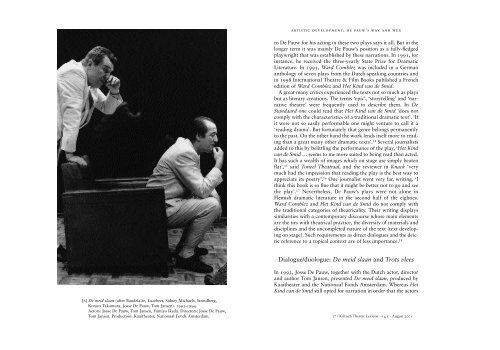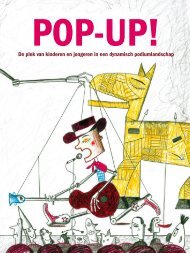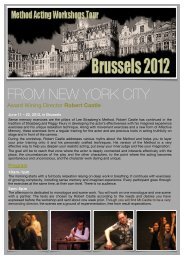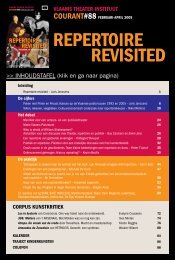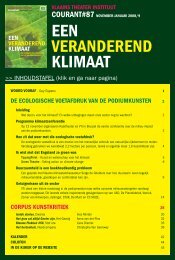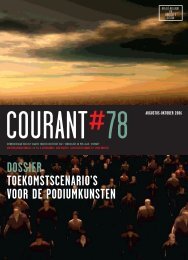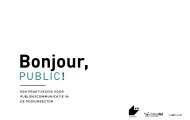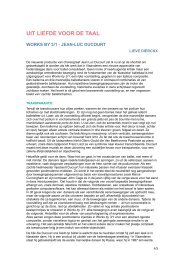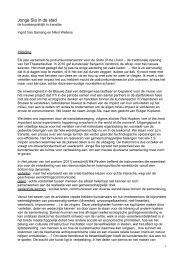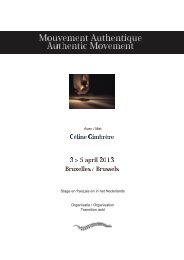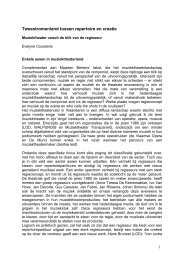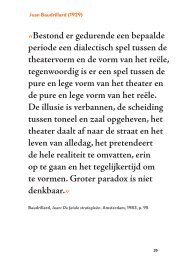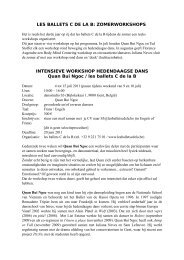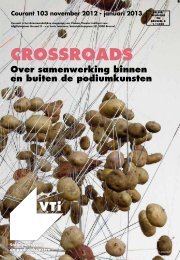Create successful ePaper yourself
Turn your PDF publications into a flip-book with our unique Google optimized e-Paper software.
[6] <strong>De</strong> meid slaan (after Baudelaire, Lucebert, Sidney Michaels, Strindberg,<br />
Kotaro Takamura, Josse <strong>De</strong> <strong>Pauw</strong>, Tom Jansen). 1993-1994.<br />
Actors: Josse <strong>De</strong> <strong>Pauw</strong>, Tom Jansen, Fumiyo Ikeda. Directors: Josse <strong>De</strong> <strong>Pauw</strong>,<br />
Tom Jansen. Production: Kaaitheater, Nationaal Fonds Amsterdam. <strong>De</strong> keizer<br />
van <strong>het</strong> verlies (Jan Fabre). Regie: Jan Fabre. Troubleyn, mei 1996. Met<br />
Dirk Roofthooft.<br />
artistic development: de pauw’s way and weg<br />
to <strong>De</strong> <strong>Pauw</strong> for his acting in these two plays says it all. But in the<br />
longer term it was mainly <strong>De</strong> <strong>Pauw</strong>’s position as a fully-fledged<br />
playwright that was established by these narrations. In 1991, for<br />
instance, he received the three-yearly State Prize for Dramatic<br />
Literature. In 1993, Ward Comblez was included in a German<br />
anthology of seven plays from the Dutch-speaking countries and<br />
in 1998 International Theatre & Film Books published a French<br />
edition of Ward Comblez and Het Kind van de Smid.<br />
A great many critics experienced the texts not so much as plays<br />
but as literary creations. The terms ‘epic’, ‘storytelling’ and ‘narrative<br />
theatre’ were frequently used to describe them. In <strong>De</strong><br />
Standaard one could read that Het Kind van de Smid ‘does not<br />
comply with the characteristics of a traditional dramatic text’. ‘If<br />
it were not so easily performable one might venture to call it a<br />
‘reading drama’. But fortunately that genre belongs permanently<br />
to the past. On the other hand the work lends itself more to reading<br />
than a great many other dramatic texts’. 14 Several journalists<br />
added to this by belittling the performance of the play, ‘Het Kind<br />
van de Smid … seems to me more suited to being read than acted.<br />
It has such a wealth of images which on stage are simply beaten<br />
flat’, 15 said Toneel Theatraal, and the reviewer in Knack ‘very<br />
much had the impression that reading the play is the best way to<br />
appreciate its poetry’. 16 One journalist went very far, writing, ‘I<br />
think this book is so fine that it might be better not to go and see<br />
the play’. 17 Nevertheless, <strong>De</strong> <strong>Pauw</strong>’s plays were not alone in<br />
Flemish dramatic literature in the second half of the eighties.<br />
Ward Comblez and Het Kind van de Smid do not comply with<br />
the traditional categories of theatricality. Their writing displays<br />
similarities with a contemporary discourse whose main elements<br />
are the ties with theatrical practice, the diversity of materials and<br />
disciplines and the uncompleted nature of the text (text developing<br />
on stage). Such requirements as direct dialogues and the deictic<br />
reference to a topical context are of less importance. 18<br />
Dialogue/duologue: <strong>De</strong> meid slaan and Trots vlees<br />
In 1993, Josse <strong>De</strong> <strong>Pauw</strong>, together with the Dutch actor, director<br />
and author Tom Jansen, presented <strong>De</strong> meid slaan, produced by<br />
Kaaitheater and the Nationaal Fonds Amsterdam. Whereas Het<br />
Kind van de Smid still opted for narration in order that the actors<br />
37 / Kritisch Theater Lexicon - 14 e - August 2001


